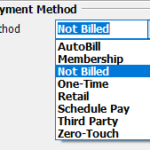Payment Methods
Spinalogic supports many different payment methods for a to pay for services in your office. Choose the methods that best suit your style of practice.
AutoBill
Autobill is where the patient pays for a specific service on a fixed schedule. Payments are made through the Zero-Touch Payment system. Most commonly in practice this is used for debt collection. Say a patient owes $500, you can set up automatic payment schedule of $10 per week for 50 weeks then set and forget. Read more…
Membership
With membership, you can bill a patient an agreed amount on a regular schedule, the provide as much care as the patient needs. It completely desyncronizes payment from care and is especially well suited to wellness models of care. Again, billing is made via the Zero-Touch Payment system. Read more…
Not Billed
Use this for staff or family for whom you don’t bill at all.
One-Time
One-time pre-pay for a specific schedule of care. e.g. $1000 for a program containing 25 adjustments at $40 each. Especially appropriate for corrective care.
Retail
The regular method of pay-over-the-counter. It can be either pay-as-you-go or you can use retail pre-pay. Retail pre-pay is when a patient say pays for 10 visits up front and their account gets progressively debited as they make their visits.
Schedule Pay
Collect a series of payments to cover a specified program of care. Payments may be scheduled for collection over the counter or by Zero-Touch or by your own manual or automatic credit card processing. Read more…
Third Party
Use anytime a third party is paying for a patient’s care – workcover, DVA, the patient’s employer etc. Read more…
Zero Touch Pay
A pay-as-you-go system without the patient needing to stop and pay every time! Takes literally 5 min to set up and your accounts will always be correct at the end of the day reconcilliation… forever. Read more…
Recommendations/Notes:
As you can see, you have a lot of choices! For a varied initial intensive or relief care, we recommend using payment systems that do not have a fixed relationship to a schedule of care. In these cases, duration of care will vary depending on a patient’s response. Use retail pre-pay or zero-touch.
In the case of corrective care, payment for a fixed program is reasonable. Use one-time or scheduled pay. Be aware that schedule pay can become complicated if you have to change a patient’s schedule of care. See Schedule-Pay for more details.
For wellness, nothing beats Membership. Some offices use this pretty much right from the start.
Tags
Accounts Admin Admin training appear appointment Appointments Calling Clinical Data Import DC Training Dictionaries Dictionary Documents Document Templates email Experts Finger Scanners firewall general settings GoLive HICAPS Hours Ignition Training Image Analysis Installation MAP Medicare Overdue patient Patient Flow Payments PDF Save Time Training Slow SMS Statements Stocktake stripe sync Tech CA Training transaction Troubleshooting Video Zero-Touch Zurili



